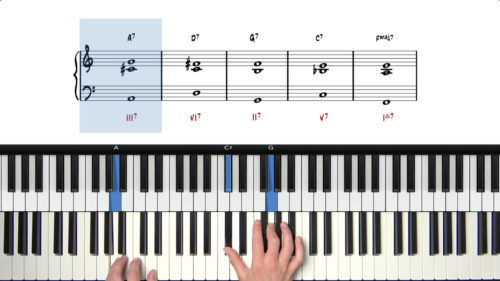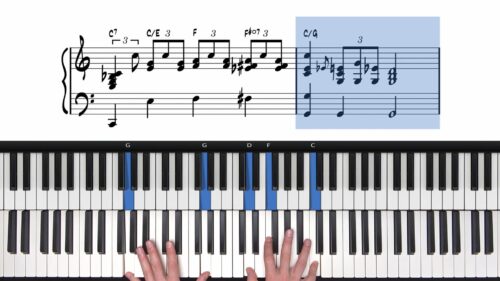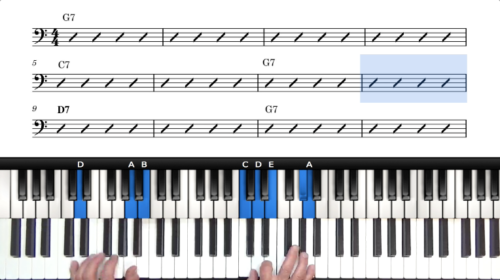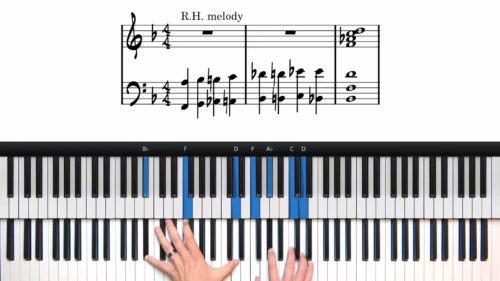Learn the tune “Georgia On My Mind” in the soulful style of Ray Charles, starting with the most basic arrangement techniques and gradually increasing the complexity.
Try a Free LessonBeginner Courses
If you’re new to the blues, start here! You will learn the 12 bar blues form, basic voicings, how to count the slow blues, filling in space, and improvisation drills and exercises.
Try a Free LessonIn this course we explore harmony and voicings, guidance for playing hymns, and improvisation techniques for jazz standards, gospel hymns, and church songs.
Try a Free LessonIn this step-by-step course we cover the blues form, bass lines, shuffle patterns, chord voicings, turnarounds & improv. Learn to play authentic Chicago Blues piano.
Try a Free LessonWe explore the core elements of improvisation such as: chord tone soloing, approach patterns, target tones and chromatic passing tones.
Try a Free LessonWe use the minor blues progression to explore pentatonic, blues scale, and modal improvisation. We apply these concepts to the famous tune “Mr P.C.”
Try a Free LessonThese lessons are designed to give you quick wins, spark your musical curiosity, and guide you toward deeper learning in our full-length blues piano courses.
Try a Free LessonOnline Blues Piano Lessons at PianoGroove
PianoGroove offers blues piano lessons with 8 world-class blues piano teachers. Our blues piano teaching team includes Grammy winners and university professors giving you an unparalleled level of insight and professional guidance to learn blues piano online. We have the largest selection of online blues piano courses to suit all levels and abilities of players. Whether you're just starting your blues piano journey, or you're a seasoned player looking to learn new tricks from our Grammy winning blues artists; we have you covered.
PianoGroove's blues piano lessons and courses are organised by Beginner/Intermediate/Advanced can be split into 3 general categories of blues. These lessons range from complete beginner level, to advanced blues tutorials taught by some of the world's best blues piano players.
Beginner Blues Piano Lessons
If you are looking for beginner blues piano lessons you are in the right place! Our course on "Slow Blues For Beginners" is one of our most popular beginner blues piano courses and is well suited to beginner and early-intermediate level students.
New Orleans Blues & Gospel
Study with world-renowned New Orleans blues players including Grammy-winner Jon Cleary, gospel specialist Davell Crawford, and New Orleans piano guru Josh Paxton. Dive into our huge library of New Orleans style piano lessons.
Jazz Blues Form & Improvisation
Our course on 12 bar blues improvisation introduces the jazz blues form and how to improvise over the blues with a backing. The jazz blues is more harmonically-sophisticated style of blues which is well suited to jazz improvisation.
Beginner Blues Piano Lessons
If you are new to blues piano, the first step is to learn the 12 bar blues form which consists of the I chord, the IV chord and V chord. These 3 chords can also be referred to as the tonic chord, the subdominant chord, and the dominant chord, and they are used to create the most basic version of the blues, also know as the 145 blues.
12 Bar Blues Piano Lessons
The 12 bar blues is the most common and popular form when playing blues piano. The Chicago Blues typically follows the 12 bar blues form as well as other closely related styles such as Barrelhouse Blues and Boogie-Woogie piano styles.
In our 12 bar blues courses we start with the 12 bar blues form and the basic harmonic structure which contains just the I chord, the IV chord, and the V chord. You will learn how to play through the 12 bar blues form with 7th chords and how to use chord inversions to smoothly connect the chords in the blues.
We cover rootless voicings for the basic 12 bar blues and also the jazz blues chord progression. If you are new to rootless harmony, check out our jazz piano course on Mastering Rootless Voicings
8 Bar Blues Piano Lessons
The 8 bar blues form is the most common blues form used when playing New Orleans piano and when playing New Orleans Blues. Whilst the 12 bar blues form can be used when playing blues in a New Orleans style, the 8 bar blues is better suited to the New Orleans piano style and offers a greater degree of freedom in terms of adding blues chord substitutions.
Start with the lesson on 8 bar blues for beginners which explains the most basic chord changes found in the 8 bar blues form and how to outline the 12/8 pulse found in Junker style blues.
Once you understand the basic chord changes you can delve into the lessons on 8 bar blues chord substitutions. The 8 bar blues form has a potentially infinite number of chord substitution options. For a very sophisticated version of the 8 bar blues check out this James Booker "True" piano lesson.
Perhaps the most iconic blues song can be found in the Tipitina blues piano lesson. Other common New Orleans blues styles are Junkers Blues which features the signature 12/8 left hand bass line pattern.
Learn about the some of the greatest New Orleans piano through our Dr John “Such A Night” piano lesson. We also have a wide selection of James Booker piano lessons which cover his unique approach to the piano including chord voicings, improvisation' and James Booker style turnarounds.
Jon Cleary’s piano lessons cover the history and evolution of New Orleans piano, and also in-depth theory lessons and demonstrations on the 12 bar blues, 8 bar blues, 12/8 grooves, Junkers Blues, and much more. Also check out the Frenchman Street Blues tutorial and take an exploration in blues harmony of Port Street Blues piano lesson.
Slow Blues Piano Lessons
Our slow blues for beginner course is a step-by-step course covering the essential elements of the 12 bar blues for solo piano performance. We start right at the beginning and learn how to count the slow blues using a 12/8 pulse. The slow blues is typically played with a 'tripet feel' which we can outline and count using the 12/8 pule. We then play the blues using triads, 7th chords, and introduce the suspended triad fill which can be used to tastefully fill in the space when playing slow blues piano.
We explore blues turnarounds for beginners and other types of blues turnaround such as the gospel style turnaround, New Orleans style turnaround, and turnarounds with blues scales.
We explore a selection of stylistic devices which will enhance your blues piano and create a more authentic slow blues sound. We start with slow blues passing chords which are usually dominant chords either a half step above or a 5th above the primary chords in the 12 bar blues. We then explore the use of suspended chords in the blues which are commonly used in gospel style blues.
The improvisation module of the slow blues course introduces triad based improvisation where we use the notes of the triad and the chromatic tones that exist within the triad shape.
Chicago Blues Piano Lessons
Blues piano comes in many different forms and styles, one of the most popular being the Chicago blues style. As a blues piano student, it's important to understand the various regional and stylistic variations within the blues genre. Our Chicago Blues Piano Courseteaches the history and evolution of the style and also the fundamental building blocks which are bass lines, shuffle patterns, comping, and improvisation.
We start by learning Chicago blues blues shuffle patterns based around a 5th and 6th interval in our left hand. This is one of the most useful patterns to learn because of its simplicity. It creates both a solid groove and harmonic interest at the same time. The 5th interval is unique because it can be played in the lower registers of the piano without it sounding “muddy.” When working on our hand independence, we must train our left hand to play this rhythm almost subconsciously, freeing up our right hand for melodic creativity.
Triads, 7th Chords, 9th Chords, & 6th/13th chords are all used in the blues piano chords and comping patterns. While we can comp with basic triad shapes, the dominant 7th is a very useful sound to incorporate into our chords and voicings when comping. We can also extend our voicings to include 9ths and 13ths. Our Chicago blues lessons demonstrate some clean voice leading principles using these colorful extended chord voicings.
Finally we explore Chicago blues licks & riffs. Perhaps the most used and common lick in the Chicago Blues style is the hammered 8th note. We also learn how to play rolls, slurs, and slides to get an authentic Chicago blues sound.
Gospel Blues Piano Lessons
Learn to play gospel chord progressions in the gospel blues masterclass course taught by iconic New Orleans pianist Davell Crawford. This course starts with an introduction to the I-IV-V blues and the. We introduce gospel passing chords & substitutions to spice up the basic blues chord changes.
This course also covers how to play hymns on piano styles, common meters and gospel time signatures for congregational performance, leading tones, improvisation, and a vocal accompaniment demonstration lesson with a gospel singer.
Soulful Gospel Blues Course
The soulful gospel blues course is designed for beginners and provides and introduction to harmonizing hymns and church music. The course starts with a focus on blues piano and a study on blues piano walk-ups and walk-downs.
You will learn to add passing chords to church hymns, how to embellish church music with soulful ornamentation, and tips and techniques for soloing such as gospel triad pattern improvisation and how to develop solo ideas.
Boogie-Woogie Piano Lessons
Are you captivated by the electrifying rhythm of Boogie-Woogie piano? The Boogie-Woogie piano course is designed for enthusiasts like you who want to dive into the world of boogie-woogie style and technique to master its infectious grooves.
We start by exploring the history Boogie-Woogie piano including the development of this genre and the influential musicians and recordings that shaped its sound.
Boogie-Woogie piano bass lines are the driving force of boogie-woogie. We covers essential bass lines and left-hand patterns that combine the roles of drummer and bass player to propel the music forward.
We then explore Boogie-Woogie riffs and licks that give boogie-woogie its infectious energy. You will learn the stylistic devices like slurs, slides, and trills, and how to incorporate them into your playing.
Walking Bass Lines For Blues Piano
Free Blues Piano Lessons
Click into any of our blues courses you will see that 1 or 2 free blues piano lessons to sample. The free lesson samples allow you to experience the teaching style and ensure that the courses are a good fit for your current level.
Every blues piano lesson is accompanied by downloadable learning supplements. The downloads include full note-for-note transcriptions of the demonstrations and performances. In addition, MIDI files are provided so that you can effortlessly transpose the demonstrations and performances into different keys using your favourite MIDI software.


















